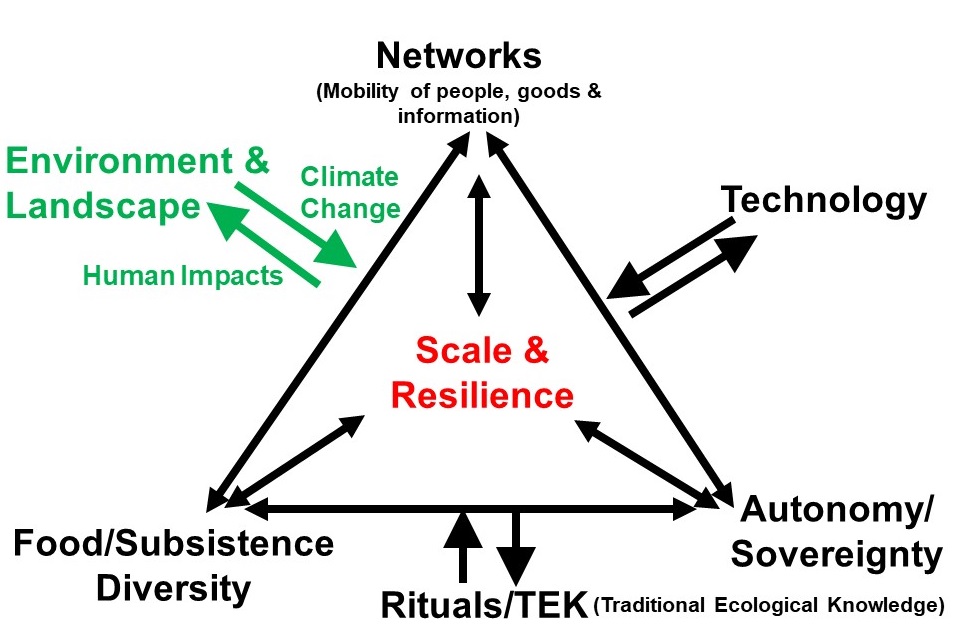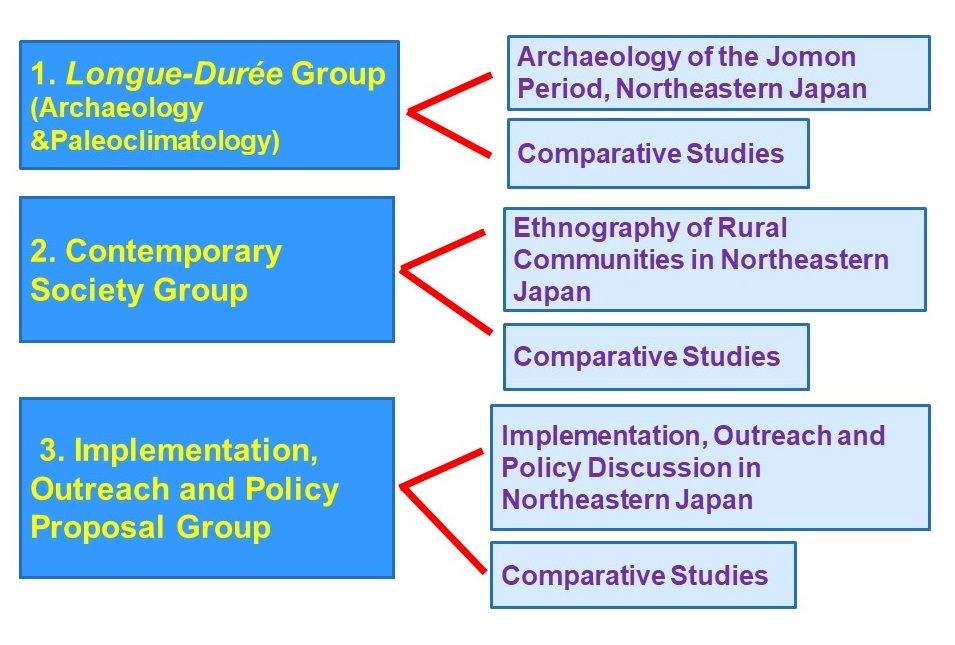Japan
Long-term Sustainability through Place-Based, Small-Scale Economies: Approaches from Historical Ecology
This project examines the importance of place-based, small-scale economies. Archaeological, ethnohistorical, and paleoenvironmental studies test our hypothesis that community sustainability has been directly linked to community scale and food diversity. The Full Research Phase of this project ended in 2017, and we are currently working on publishing the results of individual sub-projects.
Objectives
This project examines the importance of place-based, small-scale and diversified economies, particularly the importance of small-scale food production, circulation and consumption, for the long-term sustainability of human societies. The following working hypothesis begins our research: Highly specialized subsistence (food production) strategies can support a larger community for a short period, but a decrease in subsistence and food diversity makes the production system and its associated community more vulnerable in the long-run. Archaeological, historical and paleoenvironmental studies are used to test this hypothesis or examine the long-term impacts of the loss of subsistence/food diversity in relation to other environmental and cultural factors. To link these studies with the current discussion of the scale and methods of alternative food systems, ethnographic and ecological studies of contemporary small-scale food systems and communities are conducted. In combination, studies of the past and present point to the future, as the research process also involves collaborative design of ecologically sound and equitable food systems.
Preliminary results of this project indicate that diversity, network and scale are three key concepts to understand long-term sustainability of socioeconomic systems. By integrating case studies on food diversity, the mobility of people, and flows of goods and information in relation to the scale and resilience of societies and economies, this study aims to advance theories on the interrelationship between culture and environment. Other cultural factors, including technological developments, sociopolitical structure and rituals/religion, are also taken into consideration (Figure 1).
Figure 1: Mechanisms for Culture Change

Geographic Focus
Our regional focus is the North Pacific Rim. In particular, we have identified northern Japan, with its solid archaeological record and its importance to contemporary food production in Japan, as the core area of our field research. The west coast of North America, with rich traditions of ethnographic and ecological investigation as well as active contemporary food/agriculture movements, will provide main comparative case studies. These two regions share a number of characteristics in common, including climate, vegetation, fauna, and a high level of seismic activity. There are also cultural ties with historical depth as a result of the migration of anatomically modern humans after the late Pleistocene. Historically, the abundance of small-scale economies supported by marine food exploitation and intensive nut-collecting also characterize these two regions.
Figure 2: Main research areas

Research Methods and Project Organization
The project consists of three research groups, each with several sub-projects:
1) Longue-Durée Group: Archaeological, historical, and paleoenvironmental studies are used to test our working hypothesis listed above. Because of the long time span, these studies are capable of addressing the relationships between the factors shown in Figure 1. These relationships include long-term consequences of the loss of diversity and associated expansion of the scale of production, the importance of networks, and changes in community and population size.
2) Contemporary Society Group: Ethnographic and sociological studies of small-scale food production systems and their associated communities are conducted to understand the complex inter-relationships among cultural and natural contributors in contemporary urban and rural settings. Due to the lack of long time span, this group cannot directly test our working hypothesis. Nevertheless, when compared to archaeological case studies, the increased depth of our observation provides an opportunity to evaluate the importance of small-scale food production with wide food diversity in relation to other factors listed in Figure 1. Chemical and biological analysis of soil, water and food will provide direct evidence to evaluate the degree of human impacts on the environment.
3) Implementation, Outreach and Policy Proposal Group: Our emphasis on food diversity, network, and locally autonomous, small-scale production are used to develop academic and public outreach programs for instigating and promoting place-based, small-scale and diversified food production. In collaboration with educational programs, NPOs, NGOs and local community organizations, these programs develop alternative strategies to overcome problems and vulnerabilities of currently dominant large-scale, homogenous productions. Our ultimate goal is to make actionable contributions to local/national policies of rural/urban developments and food policy.
Collaboration
From 2014 to 2017, the project headquarter was based at the Research Institute for Humanity and Nature (RIHN), Kyoto, Japan. The project leader, Junko Habu, currently holds the professorship atthe Dept. of Anthropology, University of California, Berkeley. She is also the chair of the Center for Japanese Studies at UC Berkeley. The project places a strong emphasis on international collaboration. A total of 80 project members from multiple countries, including Japan, the United States, Canada, Russia, England and Spain, are taking part of this interdisciplinary research.
For more details of the project, please follow following link:
Homepage of the Small-Scale Economies Project
Final report, Small-Scale Economies project
Core members of this project have just launched a new project on agroecology: https://junkohabu.com/agro-e-project/
Contact information
Project Leader: Junko Habu, Professor, Department of Anthropology, University of California, Berkeley, USA
Mailing Address:
Junko Habu, Department of Anthropology, University of California, Berkeley, 232 Kroeber Hall, Berkeley CA 94720-3710 USA
Phone: +1-510-643-2645, Fax: +1-510-643-8557
E-mail: habu@berkeley.edu
Key publications and presentations
2016 Crema, E. R., J. Habu, K. Kobayashi and M. Madella. Summed probability distribution of 14C dates suggests regional divergences in the population dynamics of the Jomon Period in Eastern Japan. PLOS ONE 11(4): e0154809. Link
Altieri, Miguel A. and C.I. Nicholls. 2014 Agroecology and the Design of Climate Change Resilient Farming Systems. Agronomy for Sustainable Development 35(3): 869-890.
Cuthrell, Rob Q. 2013. Archaeobotanical Evidence for Indigenous Burning Practices and Foodways at CA-SMA-113. California Archaeology, 5(2): 265-290.
Grier, Colin. 2014. Landscape Construction, Ownership and Social Change in the Southern Gulf Islands of British Columbia. Canadian Journal of Archaeology, 38(1): 211-249.
Habu, Junko, 2020. Reexamining the importance of traditional ecological knowledge: Continuity and change in landscape practice in rural Japan from the prehistoric Jomon period to the present. Bag Lunch Talk series, Archaeological Research Facility, UC Berkeley, September 15. https://www.youtube.com/watch?v=AdLLR7La7Ac
Habu, J. 2018. Jomon Food Diversity, Climate Change and Long-term Sustainability: What I Have Learned by Doing Archaeological and Ethnographic Studies in Japan. SAA Archaeological Record 18(5): 27-30. PDF
2016 Habu, J. Food diversity and climate change: lessons from the Early and Middle Jomon Periods, Japan. Quarterly of Archaeological Studies [Kokokogaku Kenkyu] 63(2): 38-50 (in Japanese with English Abstract). PDF with unofficial English translation
2016 Heron, C. P., J. Habu, M. K. Owens, Y. Ito, Y. Eley, A. Lucquin, A. Radini, H. Saul C. D. Spiteri, and O. E. Craig. Molecular and isotopic investigations of pottery and ‘charred remains’ from Sannai Maruyama and Sannai Maruyama No. 9, Aomori Prefecture, Japan. Japanese Journal of Archaeology 4(1): 29-52. Link
Hosoya, Leo Aoi. 2014. The “Routine-scape” and Social Structurarization in the Formation of Japanese Agricultural Society. Geografisca Annaler: Series B, Human Geography 96 (1): 67-82.
Lightfoot, Kent G. 2013. Rethinking the Archaeology of Human/Environmental Interactions in Deep Time History. Schmidt, P.R, and S. Mrozowski, S. (Eds), The Death of Prehistory, pp. 183-200. Oxford University Press, Oxford.
Lightfoot, Kent G., Rob Q. Cuthrell, Chuck J. Striplen and Mark G. Hylkema. 2013 Rethinking the Study of Landscape Management Practices Among Hunter-Gatherers in North America. American Antiquity, 78(2), 285-301.
Thornton, Thomas. F. 2015. “The Ideology and Practice of Pacific Herring